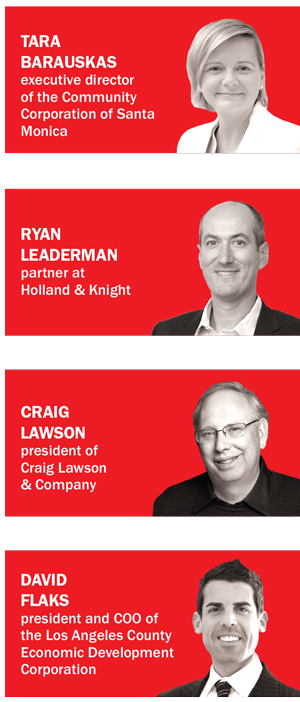
The California Environmental Quality Act, or CEQA, is one of the most divisive state laws in real estate.
In the opinion of most developers, from strictly market-rate operations to 100 percent affordable builders, it’s an absolute disaster. For anyone looking to stop or influence development projects, it’s a godsend.
At its core, the landmark 1970 law requires state and local governments to analyze and publish the impacts of development projects on the environment and mitigate them if necessary.
The law is meant to protect California’s natural environment, but its purview has greatly expanded over the last five years. A project’s impacts on views and traffic patterns are grounds for CEQA challenges in court. The law also requires that cities hear any CEQA-based appeals against projects.
Neighborhood groups and unions often use CEQA to challenge urban developments. A 2015 study by the law firm Holland & Knight found that 80 percent of CEQA lawsuits filed in California over a three-year period were against infill development projects. Many of the plaintiffs during that time had no environmental track record.
CEQA challenges rarely stop development outright, but court cases and appeals to local government bodies can eat up months and years, greatly increasing the costs for developers.
For that reason, most developers, development consultants and real estate lobbyists want to see the law amended or tossed completely.
The Real Deal asked four real estate pros what they would change about CEQA if given the chance and what could be done on the local level to ease CEQA-related restrictions.
Their answers have been edited and condensed for clarity.
 California Gov. Gavin Newsom and the state Legislature call you up on speakerphone and say they’ll sign into law whatever changes to CEQA you want. What do you tell them?
California Gov. Gavin Newsom and the state Legislature call you up on speakerphone and say they’ll sign into law whatever changes to CEQA you want. What do you tell them?
Barauskas: Figuring out a mechanism to ensure that appeals must be for legitimate environmental reasons and not NIMBYism [Not In My Back Yard] is on my wish list. CEQA is seen as a tool for obstruction by NIMBYs; that’s [affordable developers’] biggest challenge.
Flaks: Amend CEQA’s standing requirement to be more consistent with NEPA’s [the National Environmental Policy Act], and specifically require plaintiffs seeking to sue for a violation of CEQA to show that they have suffered or will suffer some sort of concrete harm that has been caused by the alleged CEQA violation and that the harm… falls within the “zone of interests” that CEQA seeks to protect. Allow standing to be challenged by a motion and discovery.
Lawson: I’d say they should exempt 100 percent of affordable housing projects and urban infill projects with permanent supportive housing from CEQA and clarify existing law so that local planning agencies can better understand how and when to grant such exemptions. They should also limit CEQA challenges to persons who have a legitimate environmental concern relating to a development project.
Leaderman: Completely abolish it, and this is coming from a CEQA attorney! Protecting the environment is very important. In practice, though, at least in highly urbanized areas where I tend to practice, CEQA has little to do with these ideals. There are numerous laws, policies, findings and other requirements associated with project approvals that can protect the environment in a more cost-effective, efficient and equitable manner than the hydra-headed monster that CEQA has become.
Coming back to the real world, what changes to CEQA do you believe are possible in the near term?
Barauskas: Right now CEQA is administered in numerous different ways, so standardizing that and also training jurisdictions on how to implement CEQA. I think those are tangible things that feel realistic. For example, Santa Monica has done environmental studies for different areas of the city and you automatically qualify for a CEQA exemption if you fall within those areas, which streamlines things a lot.
Lawson: Given the affordable housing crisis in California, and the shortage of housing for middle income households, I think that there will be additional legislation relating to CEQA exemptions for urban infill housing. I don’t think its likely there will be any changes on the CEQA challenge issue.
Leaderman: The Legislature should remove the many exceptions to CEQA exemptions that exist. To use an exemption, one often has to go through the same or similar analysis as in an environmental impact report or mitigated negative declaration to prove that none of the exceptions apply, which largely defeats one of the primary purposes of the exemption. Other near-term solutions are ending anonymous and duplicate CEQA lawsuits.
State lawmakers have tried to reform and rewrite CEQA for years. What can be done on the local level to remedy CEQA-related issues?
Barauskas: CEQA is really complex, and I think that opens it up to a lot of interpretation by jurisdictions, so having cleaner documentation, checklists and things that are more straightforward for people to utilize could be done on the local level. There’s so many gray areas because of the ability to interpret. That’s where I think the mishandling can occur.
Flaks: Since CEQA went into law, many other environmental and land use laws have been passed by multiple agencies at the federal, state and local levels, creating duplicative and overlapping processes, standards and mitigation requirements that result in lengthy project permitting delays. Certainly, we can — and must — do a much better job to modernize, rationalize and streamline the process for environmental compliance and land use standards by integrating CEQA with [these provisions].
Lawson: Most of CEQA is implemented at the local level. The best way to address CEQA-related issues is to have a comprehensive administrative record with a clear project description and legislative history. This requires continuous training at the local level, for both the private sector consultants who are preparing CEQA documents and for public sector staff members who review these documents. It’s also important to allow collaboration between the development team members and those who are writing and reviewing CEQA documents, so issues can be resolved early in the process.
Leaderman: In the City of Los Angeles, the tremendous staff turnover in the Major Projects division processing [environmental impact reports] needs to end. There also appears to be a lack of coordination and understanding amongst various city departments, such as the Fire Department, about the consequences of their actions when they review environmental documents.
What are some downsides to changing CEQA as it’s currently written?
Leaderman: Change creates uncertainty. If there is no case law on the changes, that means that it may take litigation to clear up any ambiguities and uncertainties.
